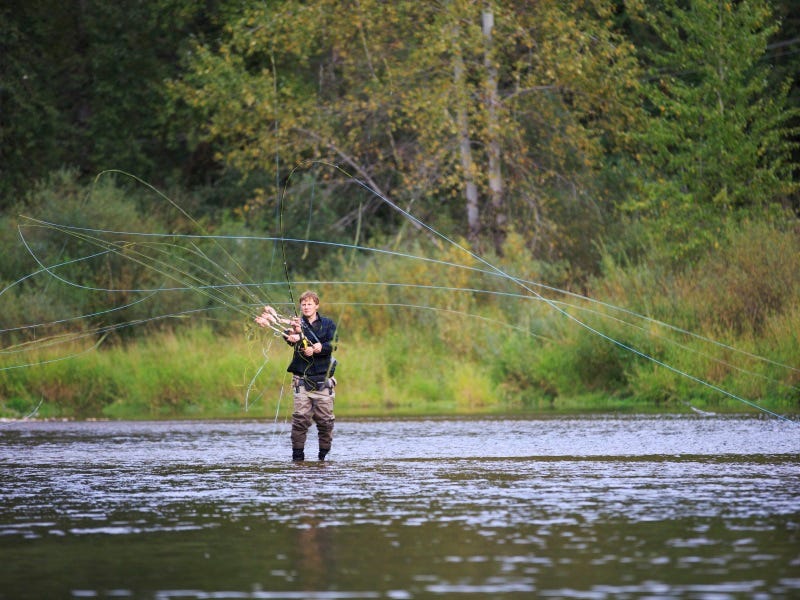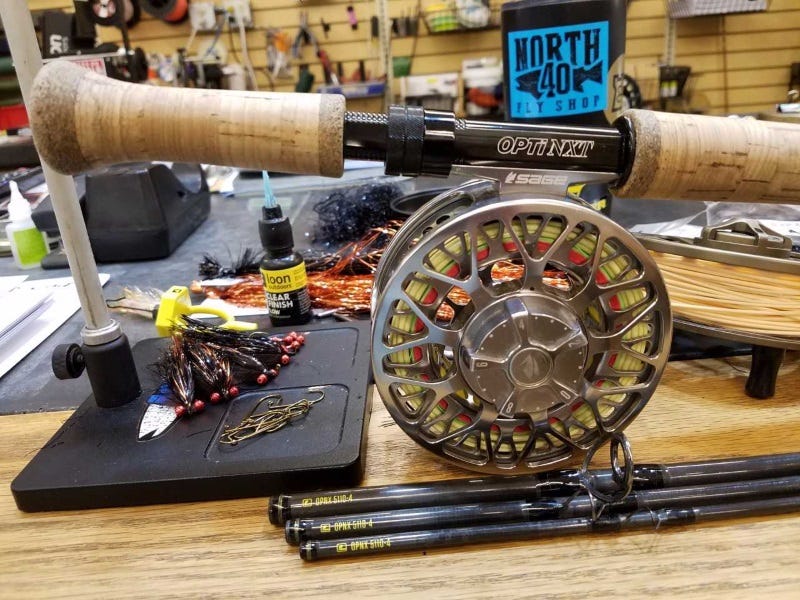Trout Spey: Fred Telleen’s Favorite Rod, Reel, Line and Tips


Picking the right trout spey rod is a personal choice and what may be perfect for one angler might not fit another. Before choosing a setup, there are many variables to consider with the bottom line is being this: You want to smile every time you touch it. I have a fishing problem and I must admit I’ve got more than one trout spey rod. More than five, actually… but who’s counting?
Today, I’ll focus on the one I’d grab if I was heading out the door today. If I had this rod in my hands right now, I’d be smiling.
Trout Spey Rod
Currently, the Loop Opti NXT 5110—meaning an 11-foot 5-weight—is the rod I’ve got loaded and ready to go. This stick is classified as a switch rod and is light enough to cast with a simple overhead motion. There are times, especially with wind in my face, when I will go that route, but the NXT also excels at spey casting. One of the things I really like about this rod is that it fishes well with a variety of lines and carries a wide grain window effectively, meaning you can pair it with several heads depending on what the situation calls for—it offers the perfect blend of adaptability for all my trout spey needs.
Trout Spey Reel
I’m far less particular about reels than I am about fly rods and lines, but having a properly functioning reel is essential to keeping that smile on your face. Have you ever stood in the middle of a river, hooked up to a large fish, and had your running line jump the gap between your spool and the reel frame? That’s guaranteed to bring on a frown and end badly.
My reel of choice is the Sage Domain 8. It’s 3-7/8 inches and is perfect for balancing an 11-foot rod. The reel features a full-frame design to minimize the chances of a running line or backing pinch.
Here's our entire catalog of fly reels.

Running Line
For running line, I prefer mono. Mono has several attributes that make it ideal for trout spey. The primary benefit is extreme slickness. This translates to less friction through the guides and less tension when peeling line off the water. For the past several years, I’ve happily fished the OPST Lazar Line in 30#.
Lines, Heads, Tips and Leaders
On another spey rod outfit I sometimes fish, my line of choice is the 320-grain Rio Scandi Short Versa Tip. I figured I’d try it on the Loop rod and see how it felt. The NXT handled it perfectly. With the Scandi Short Versa Tip system, I’ve got the flexibility of attaching intermediate, Type-3 and Type-6 tips to the head or body of the line. There is even a floating tip in my wallet, though I seldom use it. I most often use the Type-3 tip for swinging streamers on the Missouri. In Alaska, I generally run the Type-6. If fish are in shallow or slowish water, the intermediate tip comes into play.
See our selection of sink tips online here.
Recently, I was back in Alaska and the water was high. I needed a bigger tip to get my sculpin down to the fish. I set up with a 375-grain Skagit Max Short and a 12-foot sinktip. That’s a much bigger grain load than I’m used to, but even with a heavy sculpin, the Opti NXT launched it with ease.
When I’m fishing with a tip, I generally use a level section of tippet from three to five-feet long. The smaller the fly, the longer I go and vice versa. For slender leech and minnow patterns under three inches long, I like 3X. For larger and bulkier streamers, I generally use OX.
The Perfect Missouri River Spey Setup
For the Missouri River, I have another favored setup for the NXT. There are times when having an integrated line is preferred over a shooting head. If I am fishing in-close or retrieving a fly, a pure floater with no loop connections is ideal. I find that the Rio Single Hand Spey for an 8-weight fishes beautifully on the 5110 NXT. It overhead casts if needed, but excels at snake rolls and any spey-style cast you choose to launch.
When fishing Rio’s Single Hand Spey line, I run a leader from 11-to 13-feet long. I hand-tie my own, but if I’m in a hurry, I cut corners with a standard nine-foot tapered leader. I usually opt for 2X and extend the butt section with 12-18 inches of 40# mono. Then I finish it with a couple feet of 3X FC tippet. If I need the leader to sink faster, I cut it back and splice in a couple more feet of fluorocarbon.
One of the benefits of the floating line/long leader setup is that I can still achieve some depth with a relatively small, weighted fly. Then, I can get some great jiggy action during the swing or as I retrieve the fly back in. This works equally well over shallow, fast water in the summer and in the deeper, slow flows where fish stack up in the dead of winter.
The full package
Altogether, I head out to the river with one rod, and two reels. The Domain is set up with the OPST 30# running line and the Scandi Short Versa-Tip system. With the intermediate, Type-3 and Type-6 tips, I’m ready to swing flies at a variety of depths and through numerous current velocities.
My other reel is loaded with the 8-weight Rio Single Hand Spey line finished with a tapered leader. This is my go-to for fishing smaller flies, especially my favored balanced leeches. A fly box or two and a couple spools of tippet completes the package. Then I just add water and start smiling.
